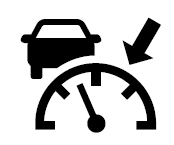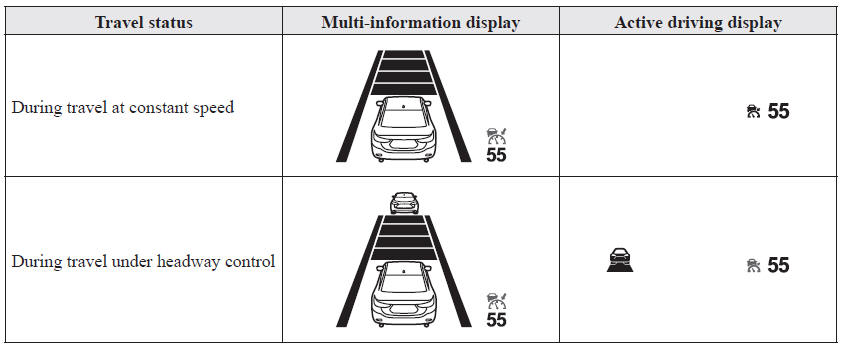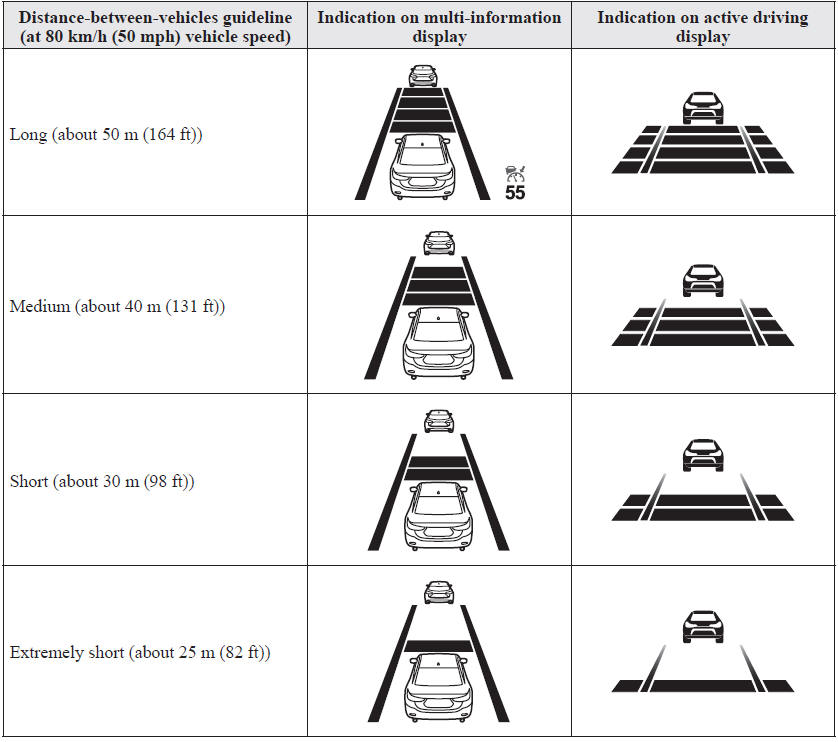Mazda 6 Owners Manual: Setting the System

When the MODE switch is pressed, the Mazda Radar Cruise Control (MRCC) main indication (white) turns on and the vehicle speed and the distance between vehicles while in headway control can be set.
NOTE
- When the ignition is switched to ACC or OFF while the Mazda Radar Cruise Control (MRCC) is ON, the Mazda Radar Cruise Control (MRCC) remains ON automatically.
- When the MODE switch is pressed while the Mazda Radar Cruise Control (MRCC) system is turned on, the system switches to the cruise control function.
How to Set the Speed
1. Adjust the vehicle speed to the desired setting using the accelerator pedal.
2. Headway control begins when the SET
 or SET
or SET
 switch is pressed. The set speed
switch is pressed. The set speed
and the inter-vehicle distance display filled with white lines are displayed. The
Mazda Radar Cruise Control (MRCC) set indication (green) is indicated simultaneously.


NOTE
- If a vehicle ahead is detected while traveling at a constant speed, the vehicle-ahead indication is displayed and headway control is performed. Additionally, when a vehicle ahead is no longer detected, the vehicle-ahead indication turns off and the system switches back to travel at constant speed.
- Headway control is not possible if the vehicle ahead is driving faster than the set speed. Adjust the system to the desired vehicle speed using the accelerator pedal.
How to Set the Distance Between Vehicles During Headway Control
The distance between vehicles is set to a shorter distance each time the
 switch is pressed.
switch is pressed.
The distance between vehicles is set to a longer distance by pressing the
 switch. The distance-between-vehicles
switch. The distance-between-vehicles
can be set to 4 levels; Long, medium, short, and extremely short distance.

NOTE
- The distance between vehicles differs depending on the vehicle speed, and the slower the vehicle speed, the shorter the distance.
- When the ignition is switched to ACC or OFF and then the engine is started again, the system automatically sets the distance between vehicles to the previous setting.
Changing the Set Vehicle Speed
Changing the set vehicle speed using the SET switch
Press the SET  switch to accelerate.
switch to accelerate.
Press the SET  switch to decelerate.
switch to decelerate.
The set vehicle speed changes as follows each time the SET switch is pressed.

NOTE
For example, the set vehicle speed is changed by pressing the SET switch four times as follows: The vehicle speed accelerates or decelerates by 4 km/h (4 mph).
To accelerate using the accelerator pedal Depress the accelerator pedal and press
and release the SET  or SET
or SET
 switch at the desired speed. If
switch at the desired speed. If
a switch cannot be operated, the system returns to the set speed when you release
your foot from the accelerator pedal.
CAUTION
The warnings and brake control do not operate while the accelerator pedal is depressed.
NOTE
- When accelerating using the SET
 switch while in headway
switch while in headway
control, the set vehicle speed can be adjusted but acceleration is not possible. If there is no longer a vehicle ahead, acceleration continues until reaching the set vehicle speed. Check the set vehicle speed by viewing the set vehicle speed display in the multi-information display and the active driving display. - When depressing the accelerator pedal, the inter-vehicle distance display in the multi-information display changes to the white-line display.
- The minimum settable speed is 30 km/h (19 mph). If the set vehicle speed
reaches 30 km/h (19 mph) using the switch operation, constant speed travel is
maintained at about 30 km/h (19 mph) even if the SET
 switch is pressed. The Mazda
switch is pressed. The Mazda
Radar Cruise Control (MRCC) system is not canceled.
To Deactivate
The Mazda Radar Cruise Control (MRCC) is deactivated when the OFF/CAN switch is pressed twice.
When the system is temporarily canceled
In the following cases, the Mazda Radar Cruise Control (MRCC) is temporarily canceled, the Mazda Radar Cruise Control (MRCC) set indication (green) is turned off, and the Mazda Radar Cruise Control (MRCC) main indication (white) is turned on.
- The OFF/CAN switch is pressed once.
- The brake pedal is depressed.
- The parking brake is applied.
- The selector lever is shifted to park (P), neutral (N) or reverse (R).
- In the following cases, the “Mazda Radar Cruise Control Canceled” indication
is displayed and the beep sounds one time.
- The vehicle speed decreases to less than 25 km (16 mph).
- The DSC has operated.
- The TCS has operated for a certain period of time.
- The Smart City Brake Support (SCBS) has operated.
- The Smart Brake Support (SBS) has operated.
- When traveling on a down slope for a long period of time.
- Any door is opened.
- The driver's seat belt is unfastened.
- There is a problem with the system.
NOTE
- The Mazda Radar Cruise Control (MRCC) system may be canceled during rain, fog, snow or other inclement weather conditions, or the front surface of the radiator grille is dirty.
- If you have temporarily canceled the Mazda Radar Cruise Control (MRCC), you can return to your previously set speed by pressing the RES switch and after all of the operation conditions have been met.
- If the Mazda Radar Cruise Control (MRCC) system is deactivated, the system does not return to the previously set speed even if the RES switch is pressed.
 Close Proximity Warning
Close Proximity Warning
If your vehicle rapidly closes in on the vehicle ahead because the vehicle applies
the brakes suddenly while you are traveling in headway control, the warning sound
activates and the brake warning ...
 Cruise Control Function
Cruise Control Function
While this function is operating, the headway control operation is canceled and
only the cruise control function operates.
The vehicle speed can be set more than about 25 km/h (16 mph).
Use the cr ...
Other materials:
Mazda 6 Owners Manual: Variable air duct (vad) control solenoid valve inspection (l3)
1. Remove the VAD control solenoid valve. (See INTAKE-AIR SYSTEM
REMOVAL/INSTALLATION.)
2. Inspect airflow between the ports under the following conditions.
If not as specified, replace the VAD control solenoid valve.
If as specified, carry out the Circuit Open/Short Inspection.
Circ ...
Mazda 6 Owners Manual: Maintenance Monitor
1. Select the icon on the home
screen to display the “Applications” screen.
2. Select “Vehicle Status Monitor” to display the current warnings.
3. Select “Maintenance” to display the maintenance list screen.
4. Switch the tab and select the setting item you want to change.
You can ...
